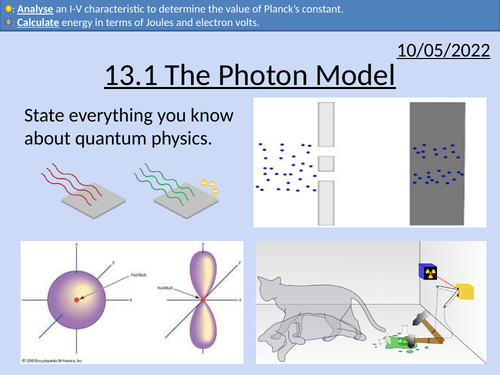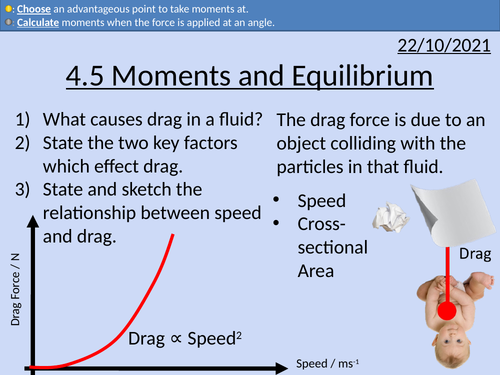497Uploads
167k+Views
71k+Downloads
All resources

OCR A level Physics: Charging Capacitors
OCR A level Physics: 21.5 Charging Capacitors
Module 6 Particles and Medical Physics
This PowerPoint is a whole lesson included with student activities, animated answers, homework questions with answers provided.
This lesson covers:
Explaining how capacitors charge with a resistor in series
Explaining how 𝑉, 𝐼, or 𝑄, change with time 𝑡 for a charging capacitor.
Sketching graphs for 𝑉, 𝐼, or 𝑄, after time 𝑡 for a charging capacitor.
Calculating 𝑉, 𝐼, or 𝑄, change with time 𝑡 for a charging capacitor.

OCR AS Physics: Kirchhoff's 1st and 2nd Law
OCR AS level Physics: Kirchhoff’s Laws and circuit diagrams is a part of the Module 4: Electrons, Waves, and Photons. PowerPoint with worked examples and homework.
Definitions of Kirchhoff’s 1st and 2nd Law
Applying Kirchhoff’s 2nd Law
Drawing circuit diagrams for parallel and series circuits

GCSE Physics: Electromagnetic Induction
This lesson presentations covers OCR Gateway Physics 9-1 P4.2.3 Electromagnetic Induction.
Definition of electromagnetic induction
How to increase electromagnetic induction
Why current is produced from electromagnetic induction
Why forces are produced from electromagnetic induction.
Exam Style question with solution

GCSE Physics: Gas Pressure & Temperature
This presentation covers OCR Gateway Physics 9-1 P1.3.1 Gas Pressure and Temperature
This presentation includes:
Introduction to kinetic theory
Relationship between temperature and pressure
Force by gas particles being normal to surface
Graph plotting - Extrapolation to absolute zero
Health and safety video on gas canisters and fires

GCSE Physics: Acceleration
This presentation covers OCR Gateway Physics 9-1 P1.2.3.
Content covered:
Definition for acceleration
Worked solutions
Students problems with answers
Exam style question with mark scheme
Bundle

GCSE OCR Physics: P1 Matter Full scheme
All resources for P1 GCSE OCR Physics Gateway 9-1.Triple and combined (Higher and Foundation) is covered in this material.
Includes:
End of topic test
Scheme of work
Development of the atomic model
Density
Temperature
Specific Latent Heat
Specific Heat Capacity
Pressure and Temperature
Pressure and Area
Pressure are Volume
Atmospheric Pressure
Liquid Pressure
Sinking and Floating

GCSE Physics: Energy Stores
This presentation covers OCR Gateway Physics 9-1 P7.1.1 Energy stores
Examples, units, and equations of each energy store:
Kinetic
Gravitational potential
Elastic
Thermal
Magnetic
Electrostatic
Chemical
Nuclear
Student activities with full worked answers also included.

OCR AS Physics: The Photon Model
OCR AS Physics A: The Photon Model is a part of the Module 4: Electrons, Waves, and Photons.
Full lesson PowerPoint with worked examples and homework with complete worked answers.
Energy of a single photon
Converting from electron-volts to Joules.
Frequency of the electromagnetic spectrum
Determining Plank’s constant with LEDs
Threshold potential difference difference

GCSE Physics: Motors
This presentation covers OCR Gateway Physics 9-1 P4.2.2 Construction of a motor.
Magnetic Field Lines
Construction of a commutator
How to increase the speed of a motor.
Student activities with worked solutions.

GCSE Physics: The National Grid
This presentation covers OCR Gateway Physics 9-1 P8.2.3 The National Grid
This PowerPoint is a whole lessons included with student activities and animated answers.
Structure of the National Grid
Step-up and Step-down transformers
How transformers increase the efficiency of the National Grid
Number of turns and potential difference
Current and potential difference in primary and secondary coils

OCR AS level Physics: The Electron Gun
OCR AS level Physics: The electron gun is a part of the Module 4: Electrons, Waves, and Photons.
Presentation come with worked examples, solutions and homeworks.
The structure of an electron gun.
The electron gun in the history of science (J.J. Thomson).
Rearranging equations to equate kinetic energy and work done.
Accelerating potential differences
Comparing the protons and electrons accelerated in a potential difference.

OCR AS level Physics: More Vectors
OCR AS level Physics: More Vectors is a part of the Module 2: Foundations of Physics
Presentation come with worked examples, solutions and homeworks.

OCR AS level Physics: Scalars and Vectors
OCR AS level Physics: Scalar and Vector Quantities is a part of the Module 2: Foundations of Physics
Full lesson PowerPoint with worked examples and homework with complete worked answers.
Definition of scalars and vectors
Adding quantities with the same units
Determining if a quantity is a vector or scalar from an equation
Comparing displacement and distance

OCR AS level Physics: Equations of Motion
OCR AS level Physics: Equations of Motion is a part of the Module 3: Forces and Motion
Presentation come with worked examples, solutions and homeworks.

OCR AS level Physics: Moments and Equilibrium
OCR AS level Physics: Moments and Equilibrium is a part of the Module 3: Forces and Motion
Presentation come with worked examples, solutions and homeworks.

OCR AS level Physics: Triangle of Forces
OCR AS level Physics: Triangle of Forces is a part of the Module 3: Forces and Motion
Presentation come with worked examples, solutions and homeworks.

OCR AS level Physics: Density and Pressure
OCR AS level Physics: Density and Pressure is a part of the Module 3: Forces and Motion
Presentation come with worked examples, solutions and homeworks.

OCR AS level Physics: Stress, Strain, &Young Modulus
OCR AS level Physics: Stress, Strain and Young Modulus is a part of the Module 3: Materials. Presentations come with worked examples, solutions and homeworks.

OCR AS level Physics: Collisions in two dimensions
OCR AS level Physics: Collisions in 2D is a part of the Module 3: Laws of Motion and Momentum. Presentations come with worked examples, solutions and homeworks.
Bundle

GCSE OCR Chemistry C1 Particles
All resources for P1 GCSE OCR Chemistry Gateway 9-1 Triple and combined (Higher and Foundation) is covered in this material.
Includes:
Introducing Particles
Chemical and Physical Changes
Limitations of the Particle Model
Atomic Structure
Isotopes and Ions
Developing the Atomic Model




















